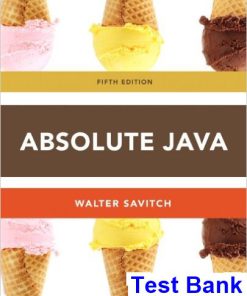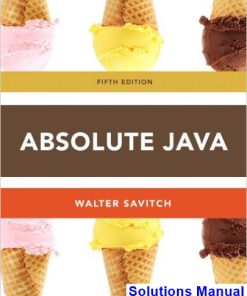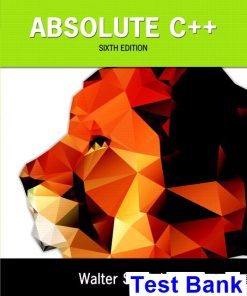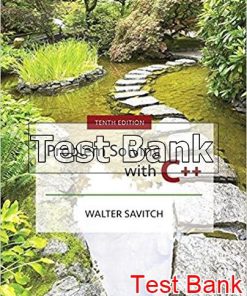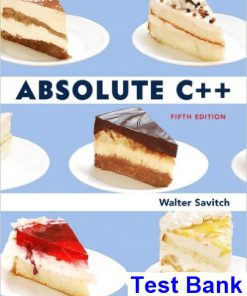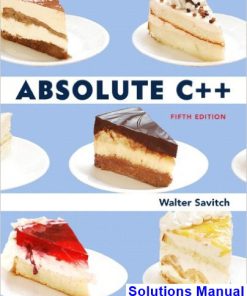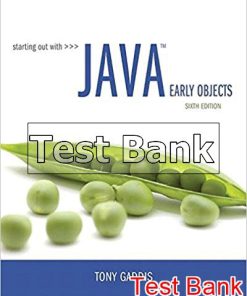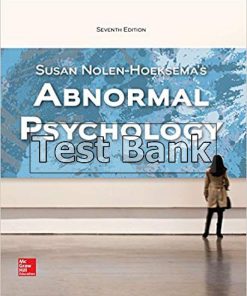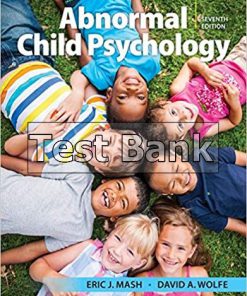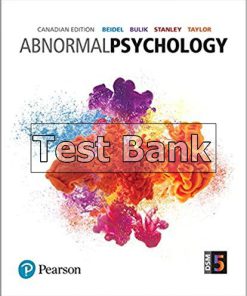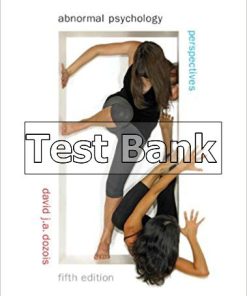Absolute Java 6th Edition Savitch Test Bank
$50.00 Original price was: $50.00.$26.50Current price is: $26.50.
Absolute Java 6th Edition Savitch Test Bank.
Absolute Java 6th Edition Savitch Test Bank
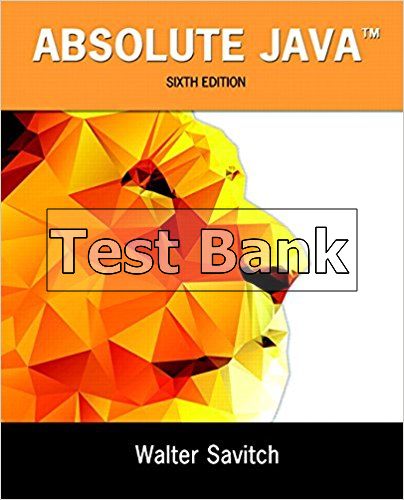
Product details:
- ISBN-10 : 0134041674
- ISBN-13 : 978-0134041674
- Author: Java
Absolute Java provides a comprehensive reference to programming in the Java language. Accessible to both beginner and intermediate programmers, the text focuses around specifically using the Java language to practice programming techniques.
The Sixth Edition is extremely flexible and easily applicable to a wide range of users. Standalone and optional chapters allow instructors to adapt the text to a variety of curse content. Highly up-to-date with new content and information regarding the use of Java, this text introduces readers to the world of programming through a widely used and relevant language.
Table contents:
- 1 Getting Started
- Introduction
- Prerequisites
- 1.1 Introduction to Java
- Origins of the Java Language ★
- Objects and Methods
- Applets ★
- A Sample Java Application Program
- Self-Test Exercises
- Byte-Code and the Java Virtual Machine
- Class Loader ★
- Compiling a Java Program or Class
- Running a Java Program
- Self-Test Exercises
- 1.2 Expressions and Assignment Statements
- Identifiers
- Variables
- Assignment Statements
- More Assignment Statements ★
- Self-Test Exercises
- Assignment Compatibility
- Constants
- Arithmetic Operators and Expressions
- Parentheses and Precedence Rules ★
- Integer and Floating-Point Division
- Self-Test Exercises
- Type Casting
- Increment and Decrement Operators
- Self-Test Exercises
- 1.3 The Class String
- String Constants and Variables
- Concatenation of Strings
- Classes
- String Methods
- Escape Sequences
- String Processing
- The Unicode Character Set ★
- Self-Test Exercises
- 1.4 Program Style
- Naming Constants
- Java Spelling Conventions
- Comments
- Indenting
- Self-Test Exercises
- Chapter Summary
- Answers to Self-Test Exercises
- Programming Projects
- 2 Console Input and Output
- Introduction
- Prerequisites
- 2.1 Screen Output
- System.out println
- Self-Test Exercises
- Formatting Output with printf
- Self-Test Exercises
- Money Formats Using NumberFormat ★
- Importing Packages and Classes
- Self-Test Exercises
- The DecimalFormat Class ★
- 2.2 Console Input Using the Scanner Class
- The Scanner Class
- The Empty String
- Self-Test Exercises
- Other Input Delimiters
- Self-Test Exercises
- 2.3 Introduction to File Input
- The Scanner Class for Text File Input
- Self-Test Exercises
- Chapter Summary
- Answers to Self-Test Exercises
- Programming Projects
- 3 Flow of Control
- Introduction
- Prerequisites
- 3.1 Branching Mechanism
- if-else Statements
- Omitting the else
- Compound Statements
- Nested Statements
- Self-Test Exercises
- Multiway if-else Statement
- Self-Test Exercises
- The switch Statement
- Self-Test Exercises
- The Conditional Operator ★
- 3.2 Boolean Expressions
- Simple Boolean Expressions
- Lexicographic and Alphabetic Order
- Self-Test Exercises
- Building Boolean Expressions
- Self-Test Exercises
- Evaluating Boolean Expressions
- Short-Circuit and Complete Evaluation
- Precedence and Associativity Rules
- Self-Test Exercises
- 3.3 Loops
- while Statement and do-while Statement
- Algorithms and Pseudocode
- Self-Test Exercises
- The for Statement
- The Comma in for Statements
- Nested Loops
- Self-Test Exercises
- The break and continue Statements ★
- The exit Statement
- 3.4 Debugging
- Loop Bugs
- Tracing Variables
- General Debugging Techniques
- Preventive Coding
- Assertion Checks ★
- Self-Test Exercises
- 3.5 Random Number Generation ★
- The Random Object
- The Math.random() Method
- Self-Test Exercises
- Chapter Summary
- Answers to Self-Test Exercises
- Programming Projects
- 4 Defining Classes I
- Introduction
- Prerequisites
- 4.1 Class Definitions
- Instance Variables and Methods
- Self-Test Exercises
- More about Methods
- Self-Test Exercises
- Local Variables
- Blocks
- Self-Test Exercises
- Parameters of a Primitive Type
- Self-Test Exercises
- Simple Cases with Class Parameters
- The this Parameter
- Self-Test Exercises
- Methods That Return a Boolean Value
- The Methods equals and toString
- Recursive Methods
- Self-Test Exercises
- 4.2 Information Hiding and Encapsulation
- public and private Modifiers
- Self-Test Exercises
- Accessor and Mutator Methods
- Preconditions and Postconditions
- Self-Test Exercises
- 4.3 Overloading
- Rules for Overloading
- Self-Test Exercises
- 4.4 Constructors
- Constructor Definitions
- Self-Test Exercises
- Default Variable Initializations
- An Alternative Way to Initialize Instance Variables
- The StringTokenizer Class ✶
- Self-Test Exercises
- Chapter Summary
- Answers to Self-Test Exercises
- Programming Projects
- 5 Defining Classes II
- Introduction
- Prerequisites
- 5.1 Static Methods and Static Variables
- Static Methods
- Self-Test Exercises
- Static Variables
- Self-Test Exercises
- The Math Class
- Self-Test Exercises
- Wrapper Classes
- Automatic Boxing and Unboxing
- Self-Test Exercises
- Static Methods in Wrapper Classes
- Self-Test Exercises
- 5.2 References and Class Parameters
- Variables and Memory
- References
- Class Parameters
- Display 5.16 Comparing Parameters of a Class Type and a Primitive Type
- Self-Test Exercises
- The Constant null
- The new Operator and Anonymous Objects
- Self-Test Exercises
- 5.3 Using and Misusing References
- Self-Test Exercises
- Copy Constructors
- Self Test Exercises
- Mutable and Immutable Classes
- Self-Test Exercises
- 5.4 Packages and javadoc
- Packages and import Statements
- The Package java.lang
- Package Names and Directories
- The Default Package
- Specifying a Class Path When You Compile ★
- Name Clashes ★
- Self-Test Exercises
- Introduction to javadoc ★
- Commenting Classes for javadoc ★
- Running javadoc ★
- Self-Test Exercises
- Chapter Summary
- Answers to Self-Test Exercises
- Programming Projects
- 6 Arrays
- Introduction
- Prerequisites
- 6.1 Introduction to Arrays
- Creating and Accessing Arrays
- The length Instance Variable
- Initializing Arrays
- Self-Test Exercises
- 6.2 Arrays and References
- Arrays Are Objects
- Array Parameters
- Self-Test Exercises
- Arguments for the Method main ★
- Methods That Return an Array
- Self-Test Exercises
- 6.3 Programming with Arrays
- Partially Filled Arrays
- Self-Test Exercises
- The “for-each” Loop ★
- Methods with a Variable Number of Parameters ★
- Self-Test Exercises
- Privacy Leaks with Array Instance Variables
- Self-Test Exercises
- Self-Test Exercises
- Enumerated Types ★
- Self-Test Exercise
- 6.4 Multidimensional Arrays
- Multidimensional Array Basics
- Using the length Instance Variable
- Self-Test Exercise
- Ragged Arrays ★
- Multidimensional Array Parameters and Returned Values
- Self-Test Exercises
- Chapter Summary
- Answers to Self-Test Exercises
- Programming Projects
- 7 Inheritance
- Introduction
- Prerequisites
- 7.1 Inheritance Basics
- Derived Classes
- Overriding a Method Definition
- Changing the Return Type of an Overridden Method
- Changing the Access Permission of an Overridden Method
- The super Constructor
- Self-Test Exercises
- The this Constructor
- Self-Test Exercises
- 7.2 Encapsulation and Inheritance
- Self-Test Exercises
- Protected and Package Access
- Self-Test Exercises
- 7.3 Programming with Inheritance
- Access to a Redefined Base Method
- Self-Test Exercises
- The Class Object
- The Right Way to Define equals
- Self-Test Exercises
- Chapter Summary
- Answers to Self-Test Exercises
- Programming Projects
- 8 Polymorphism and Abstract Classes
- Introduction
- Prerequisites
- 8.1 Polymorphism
- Late Binding
- The final Modifier
- Self-Test Exercises
- Late Binding with toString
- Downcasting and Upcasting
- Self-Test Exercises
- A First Look at the clone Method
- 8.2 Abstract Classes
- Abstract Classes
- Self-Test Exercises
- Chapter Summary
- Answers to Self-Test Exercises
- Programming Projects
- 9 Exception Handling
- Introduction
- Prerequisites
- 9.1 Exception Handling Basics
- try-catch Mechanism
- Exception Handling with the Scanner Class
- Self-Test Exercises
- Throwing Exceptions
- Exception Classes
- Exception Classes from Standard Packages
- Self-Test Exercises
- Defining Exception Classes
- Self-Test Exercises
- Multiple catch Blocks
- Self-Test Exercises
- 9.2 Throwing Exceptions in Methods
- Throwing an Exception in a Method
- Declaring Exceptions in a throws Clause
- Exceptions to the Catch or Declare Rule
- throws Clause in Derived Classes
- When to Use Exceptions
- Event-Driven Programming ★
- Self-Test Exercises
- 9.3 More Programming Techniques for Exception Handling
- The finally Block ★
- Self-Test Exercises
- Rethrowing an Exception ★
- The AssertionError Class ★
- ArrayIndexOutOfBoundsException
- Chapter Summary
- Answers to Self-Test Exercises
- Programming Projects
- 10 File I/O
- Introduction
- Prerequisites
- 10.1 Introduction to File I/O
- Streams
- Text Files and Binary Files
- Self-Test Exercises
- 10.2 Text Files
- Writing to a Text File
- Appending to a Text File
- Self-Test Exercises
- Reading from a Text File
- Reading a Text File Using Scanner
- Testing for the End of a Text File with Scanner
- Self-Test Exercises
- Reading a Text File Using BufferedReader
- Self-Test Exercises
- Testing for the End of a Text File with BufferedReader
- Self-Test Exercises
- Path Names
- Nested Constructor Invocations
- Self-Test Exercises
- System.in, System.out, and System.err
- Self-Test Exercises
- 10.3 The File Class
- Programming with the File Class
- Self-Test Exercises
- 10.4 Binary Files ★
- Writing Simple Data to a Binary File
- UTF and writeUTF
- Reading Simple Data from a Binary File
- Self-Test Exercises
- Self-Test Exercises
- Checking for the End of a Binary File
- Self-Test Exercises
- Binary I/O of Objects
- The Serializable Interface
- Array Objects in Binary Files
- Self-Test Exercises
- 10.5 Random Access to Binary Files ★
- Reading and Writing to the Same File
- Self-Test Exercises
- Chapter Summary
- Answers to Self-Test Exercises
- Programming Projects
- Projects Involving Only Text Files
- Projects Involving Binary Files
- 11 Recursion
- Introduction
- Prerequisites
- 11.1 Recursive void Methods
- Tracing a Recursive Call
- A Closer Look at Recursion
- Self-Test Exercises
- Stacks for Recursion ★
- Recursion versus Iteration
- Self-Test Exercises
- 11.2 Recursive Methods That Return a Value
- General Form for a Recursive Method That Returns a Value
- Self-Test Exercises
- 11.3 Thinking Recursively
- Recursive Design Techniques
- Binary Search ★
- Efficiency of Binary Search ★
- Self-Test Exercise
- Self-Test Exercises
- Chapter Summary
- Answers to Self-Test Exercises
- Programming Projects
- 12 UML and Patterns
- Introduction
- Prerequisites
- 12.1 UML
- History of UML
- UML Class Diagrams
- Class Interactions
- Inheritance Diagrams
- More UML
- Self-Test Exercises
- 12.2 Patterns ★
- Adaptor Pattern ★
- The Model-View-Controller Pattern ★
- Restrictions on the Sorting Pattern
- Efficiency of the Sorting Pattern ★
- Pattern Formalism
- Self-Test Exercises
- Chapter Summary
- Answers to Self-Test Exercises
- Programming Projects
- 13 Interfaces and Inner Classes
- Introduction
- Prerequisites
- 13.1 Interfaces
- Interfaces
- Abstract Classes Implementing Interfaces
- Derived Interfaces
- Self-Test Exercises
- The Comparable Interface
- Self-Test Exercises
- Defined Constants in Interfaces
- Self-Test Exercises
- The Serializable Interface ★
- The Cloneable Interface
- Self-Test Exercises
- 13.2 Simple Uses of Inner Classes
- Helping Classes
- Self-Test Exercises
- The .class File for an Inner Class
- 13.3 More about Inner Classes
- Static Inner Classes
- Self-Test Exercises
- Public Inner Classes
- Self-Test Exercises
- Nesting Inner Classes
- Inner Classes and Inheritance
- Anonymous Classes
- Self-Test Exercise
- Chapter Summary
- Answers to Self-Test Exercises
- Programming Projects
- 14 Generics and the ArrayList Class
- Introduction
- Prerequisites
- 14.1 The ArrayList Class
- Using the ArrayList Class
- Self-Test Exercises
- Methods in the Class ArrayList
- The “for-each” Loop
- Self-Test Exercises
- Self-Test Exercises
- The Vector Class
- Parameterized Classes and Generics
- 14.2 Generics
- Generic Basics
- Bounds for Type Parameters
- Generic Methods ★
- Inheritance with Generic Classes ★
- Self-Test Exercises
- Chapter Summary
- Answers to Self-Test Exercises
- Programming Projects
- 15 Linked Data Structures
- Introduction
- Prerequisites
- 15.1 Java Linked Lists
- Working with Linked Lists
- Self-Test Exercises
- Node Inner Classes
- Self-Test Exercises
- The equals Method for Linked Lists
- 15.2 Copy Constructors and the clone Method ★
- Simple Copy Constructors and clone Methods ★
- Exceptions ★
- Self-Test Exercises
- 15.3 Iterators
- Defining an Iterator Class
- Adding and Deleting Nodes
- Self-Test Exercises
- 15.4 Variations on a Linked List
- Doubly Linked List
- Self-Test Exercises
- The Stack Data Structure
- Self-Test Exercise
- The Queue Data Structure
- Self-Test Exercise
- Running Times and Big-O Notation
- Self-Test Exercises
- Efficiency of Linked Lists
- 15.5 Hash Tables with Chaining
- A Hash Function for Strings
- Efficiency of Hash Tables
- Self-Test Exercises
- 15.6 Sets
- Fundamental Set Operations
- Efficiency of Sets Using Linked Lists
- Self-Test Exercises
- 15.7 Trees
- Tree Properties
- Preorder Processing
- Inorder Processing
- Postorder Processing
- Efficiency of Binary Search Trees ★
- Self-Test Exercises
- Chapter Summary
- Answers to Self-Test Exercises
- Programming Projects
- 16 Collections, Maps, and Iterators
- Introduction
- Prerequisites
- 16.1 Collections
- Wildcards
- The Collection Framework
- Self-Test Exercises
- Concrete Collection Classes
- Self-Test Exercises
- Differences between ArrayList<T> and Vector<T>
- Nonparameterized Version of the Collection Framework ★
- 16.2 Maps
- Concrete Map Classes
- Self-Test Exercises
- 16.3 Iterators
- The Iterator Concept
- The Iterator<T> Interface
- List Iterators
- Self-Test Exercises
- Chapter Summary
- Answers to Self-Test Exercises
- Programming Projects
- 17 Swing I
- Introduction
- Prerequisites
- 17.1 Event-Driven Programming
- Events and Listeners
- 17.2 Buttons, Events, and Other Swing Basics
- Self-Test Exercises
- Buttons
- Action Listeners and Action Events
- Self-Test Exercises
- Self-Test Exercises
- Labels
- Color
- Self-Test Exercises
- 17.3 Containers and Layout Managers
- Border Layout Managers
- Flow Layout Managers
- Grid Layout Managers
- Self-Test Exercises
- Panels
- The Container Class
- Self-Test Exercises
- The Model-View-Controller Pattern ★
- Self-Test Exercises
- 17.4 Menus and Buttons
- Menus, Menu Items, and Menu Bars
- Nested Menus ★
- The AbstractButton Class
- The setActionCommand Method
- Listeners as Inner Classes ★
- Self-Test Exercises
- 17.5 Text Fields and Text Areas
- Text Fields and Text Areas
- Self-Test Exercises
- A Swing Calculator
- Self-Test Exercises
- Chapter Summary
- Answers to Self-Test Exercises
- Programming Projects
- 18 Swing II
- Introduction
- Prerequisites
- 18.1 Window Listeners
- The dispose Method
- The WindowAdapter Class
- Self-Test Exercises
- 18.2 Icons and Scroll Bars
- Icons
- Self-Test Exercises
- Scroll Bars
- Self-Test Exercises
- 18.3 The Graphics Class
- Coordinate System for Graphics Objects
- The Method paint and the Class Graphics
- Drawing Ovals
- Drawing Arcs
- Self-Test Exercises
- Rounded Rectangles ★
- paintComponent for Panels
- Action Drawings and repaint
- Some More Details on Updating a GUI ★
- 18.4 Colors
- Specifying a Drawing Color
- Defining Colors
- The JColorChooser Dialog Window
- Self-Test Exercises
- 18.5 Fonts and the drawString Method
- The drawString Method
- Fonts
- Self-Test Exercises
- Chapter Summary
- Answers to Self-Test Exercises
- Programming Projects
- 19 Java Never Ends
- Introduction
- Prerequisites
- 19.1 Multithreading
- Thread.sleep
- The getGraphics Method
- Fixing a Nonresponsive Program Using Threads
- The Class Thread
- The Runnable Interface ★
- Self-Test Exercises
- Race Conditions and Thread Synchronization ★
- Self-Test Exercises
- 19.2 Networking with Stream Sockets
- Sockets
- Sockets and Threading
- The URL Class
- Self-Test Exercises
- 19.3 JavaBeans
- The Component Model
- The JavaBeans Model
- Self-Test Exercises
- 19.4 Java and Database Connections
- Relational Databases
- Java DB and JDBC
- SQL
- Self-Test Exercises
- 19.5 Web Programming with Java Server Pages
- Applets, Servlets, and Java Server Pages
- Oracle GlassFish Enterprise Server
- HTML Forms—the Common Gateway Interface
- JSP Declarations, Expressions, Scriptlets, and Directives
- Self-Test Exercises
- 19.6 Introduction to Functional Programming in Java 8
- Self-Test Exercises
- 19.7 Introduction to JavaFX
- Self-Test Exercises
- Chapter Summary
- Answers to Self-Test Exercises
- Programming Projects
- 20 Applets and HTML
- Introduction
- Prerequisites
- 20.1 A Brief Introduction to HTML
- HTML Formatting Commands
- Outline of an HTML Document
- Hyperlinks
- Inserting a Picture
- Self-Test Exercises
- 20.2 Programming Applets
- Defining an Applet
- Running an Applet
- Menus in a JApplet
- Self-Test Exercises
- Adding Icons to an Applet ★
- Self-Test Exercises
- 20.3 Applets in HTML Documents
- Inserting an Applet in an HTML Document
- Running an Applet over the Internet ★
- Self-Test Exercises
- Applets and Security ★
- Self-Test Exercises
- Chapter Summary
- Answers to Self-Test Exercises
- Programming Projects
- 1 Keywords
- 2 Precedence and Associativity Rules
- 3 ASCII Character Set
- 4 Format Specifications for printf
- Syntax
- 5 Summary of Classes and Interfaces
- Abstract Button
- ArrayList<T>
- Boolean
- BufferedReader
- Byte
- Character
- Collection<T> Interface
- Color
- Comparable Interface
People also search:
absolute java 6th edition pdf reddit
absolute java 6th edition solutions
absolute java walter savitch 6th edition
absolute java 5th edition pdf
0 to absolute infinity 64x speed
Instant download after Payment is complete
You may also like…
Information Technology
Information Technology
Information Technology
Information Technology
Information Technology
Information Technology
Information Technology




